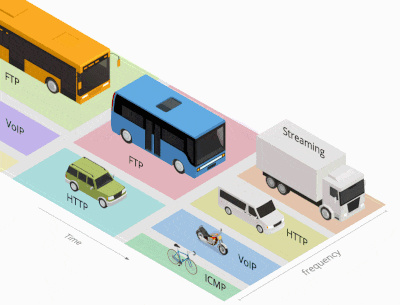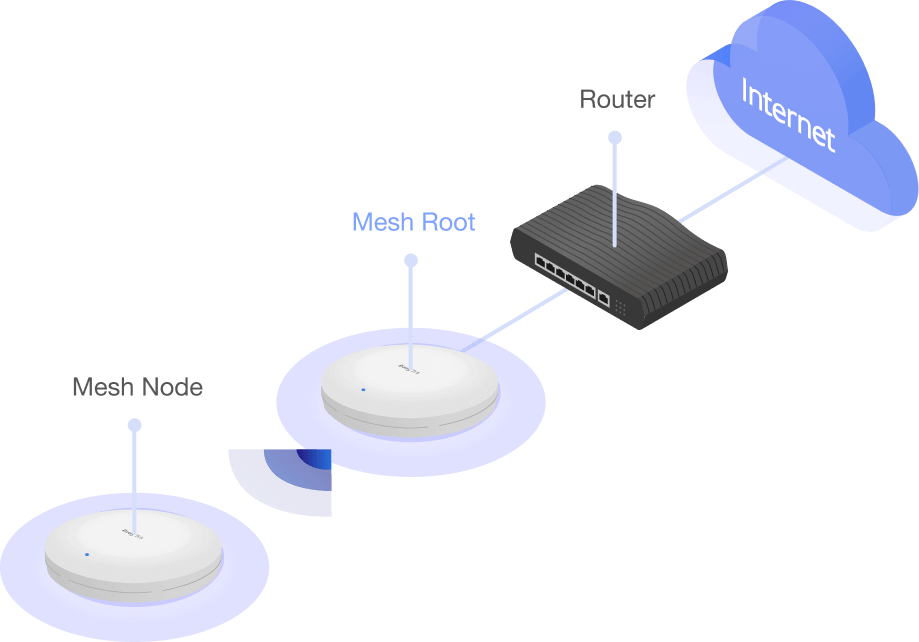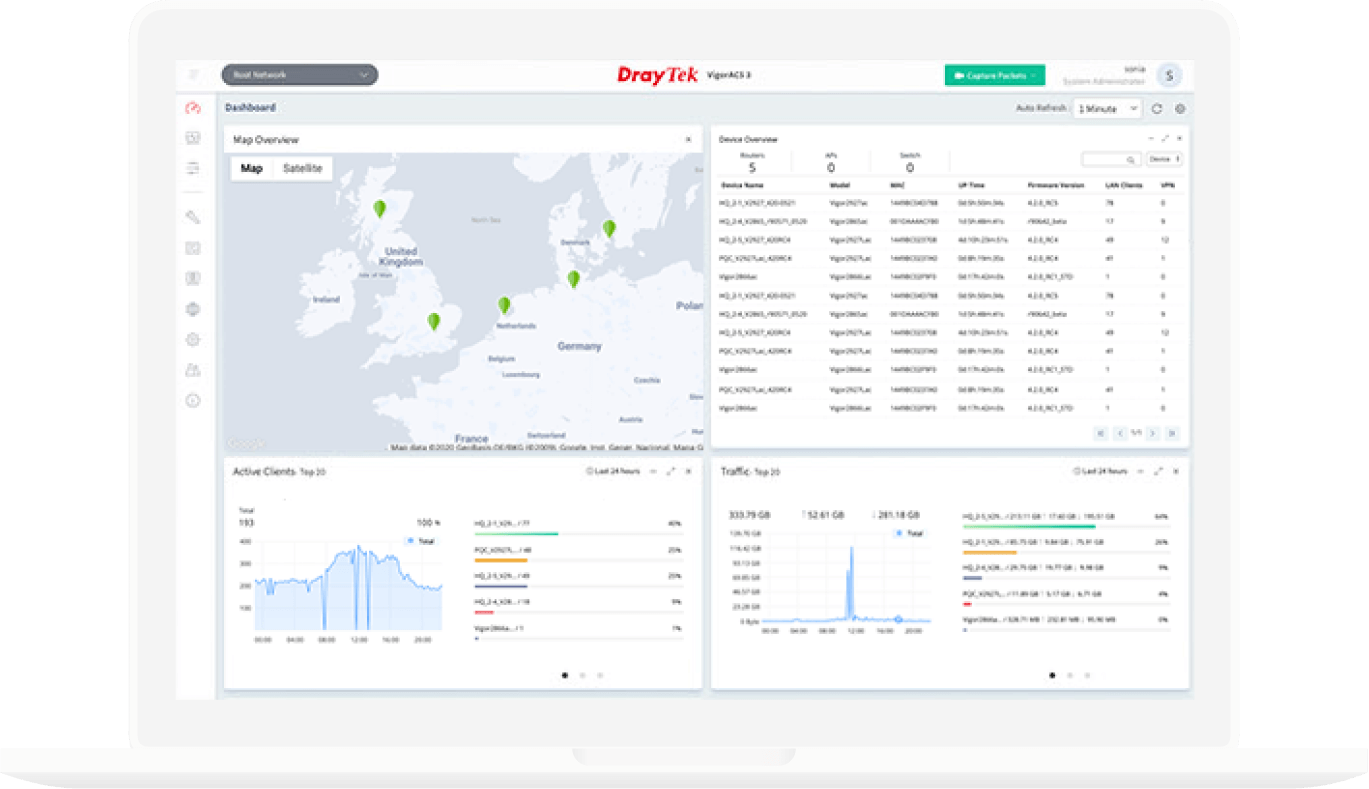Pro Performance AP with Pro Management
VigorAP 1060C is the most powerful wireless AP we’ve ever made. With 3.6 Gbps aggregated max link rate, it’s suitable for high density environments. It can be cloud-managed by VigorACS, and also act as the master AP to manage up to 50 node VigorAPs in LAN.
Dual-Band
Concurrent 5GHz and 2.4GHz
& 1 x 2.4/5 GHz RF Analytics Band
AX3600
Delivers link rate up to 3.6 Gbps
256 Users
Acitve at maximum, 128 per radio
1x 2.5G LAN
PoE Capable Port
Interface

1Factory Reset Button
2
LAN:2.5G/1G/100M/10M Base-T RJ-45
PoE-PD Support
3DC Power Input
4Security Lock
Key Features
WiFi 6 (ax model only)
Feature OFDMA and MU-MIMO technology to improve WiFi efficiency and deliver higher wireless speed.
Mesh (Wireless model only)
Easily link to other VigorAP to expand the wireless network. Learn more
PoE Power Supply
Simplify the infrastructure by getting data and power through a single cable.
Multiple SSID
Mapping WiFi clients to different VLANs and have a different set of security standards Learn how
Airtime Fairness
Equalize the transmission time of each client so the legacy devices won't slow everyone down. Learn more
Band Steering
Redirect 5GHz-capable devices to the 5GHz radio to get a faster speed. Learn more
Assisted WiFi Roaming
Solve the sticky client problem and improve WiFi roaming experience. Learn more
WiFi Scheduling
Schedule WiFi On and Off to control wireless access and save energy.
Local RADIUS Server
User profile database for local and external 802.1x authentication.
Hotspot Web Portal
Market your business and communicate with the guests while offering hospitality WLAN. Learn more
Central AP Management
Manage, maintain, and monitor VigorAP 1060C from the DrayTek routers. Learn more
Utilize Transmission Opportunity with OFDMA
OFDMA has been used in LTE for many years, and is now available in 802.11ax for multi-user mode.
Traditionally with OFDM, each frame is transmitted across the entire channel width. With low-rate transmission still using the whole channel, it brings latency and jitter to others and lower the overall efficiency.
OFDMA splits a single transmission into groups of subcarriers, and each subcarrier can be used by different client. With multiple clients transmitting simultaneously in the same channel, it improves efficiency of every single transmission opportunity and thus increases the wireless experiences in high density environment.
OFDM

OFDMA

Third Radio for RF Analytics & Security
RF Analytics & Auto Channel
VigorAP 1060C with a dedicated third radio is able to constantly monitor on all channels for airtime availability and channel utilization. It will always show the 3 best quality channels for Admin’s selection.

Wireless Security with WIDS
The radio can also keep monitoring on rouge AP. When detecting unknown AP broadcasting the same SSID, VigorAP 1060C can notify network admin for further action.

Client Management with Captive Portal
Hotspot with External Captive Portal Server
Working as NAS (network access server), VigorAP 1060C supports the 802.1x standard. It can redirect new clients to the designated portal server to go through the hotspot login process and receive corresponding RADIUS attributes and perform bandwidth limit and time limit accordingly. This function is ideal for retail, restaurants, coffee shops, and hospitality to do WiFi marketing and learn more about their clients.

Mobile Device Management
Station List and Allow/Block List
The VigorAP records associated devices with signal strength, airtime, link rate, data usage, etc. Network admin can track clients connectivity and activities history on this single panel. If spotting suspicious activities, allow/block policies can also be made right away by MAC or device type.

Nearby Station Analytics
The VigorAP tracks MAC addresses from both associated and non-associated devices with signal strength. This information could help retails and hospitality customers to understand visitor behaviors, and to optimize their business with opening hours/marketing campaigns accordingly.

WiFi Roaming
Solve the sticky client problem and improve WiFi roaming experience.

Proactive Roaming
WiFi clients automatically hand-off to another AP/Router with a better signal strength when moving around in an area with multiple APs/Routers.
However, WiFi clients sometimes stick to the AP/Router with weak signal, and not switching to the one with better signal.
Assisted Roaming
VigorAP will disassociate the WiFi clients who are out of the effective transmission range, forcing them to pick up another AP/Router with a stronger signal.
Stronger Signal Guaranteed
Furthermore, with "Minimum RSSI with Adjacent AP" option, VigorAP can disassociate the client only when other AP/router has a stronger wireless signal, and keep client stayed when there’s no other AP/Router nearby.
Stronger Signal Guaranteed
By using the "Minimum RSSI with Adjacent AP" option, the AP/Router on the same local subnet will exchange client information with each other, providing the choice to disassociate the client only when other AP detecting a stronger signal. Thus to keep the client stayed when there is no other AP nearby.
Root AP for AP Management
VigorAP 1060C is capable of working as the Root AP and manage up to 50 Node APs within the same LAN subnet.

Top-Level Root AP
AP Management can work alongside with Mesh in a more top-level manner. Root AP can manage wired APs which operate in either AP mode or Mesh Root mode. After receiving provision from Root AP, Mesh Root can then synchronize configuration with its mesh members accordingly.
In small installation within 8 APs, Mesh with wired and wireless nodes is handy; while in larger installation, hybrid solution with AP management and Mesh is more competent.
Retain High Performance
Unlike the performance decay brought by mesh wireless uplink, Node AP with wired uplink constantly provides high performance experience, and thus we always suggest to use wired uplink when possible.
Zero Touch Deployment
After auto-detecting and adding Node AP into management list, Root AP will provision relevant AP configurations to node APs.
Node AP Monitoring
Node APs are presented with IP address, operating channel, SSID of each radio, number of clients, and firmware version all in one page, and the AP offline can be easily spotted.
Three Modes in One
AP Mode

- The mode mostly used
- VigorAP acts as a bridge between wireless devices and wired Ethernet network, and exchanges data between them.
Pros
- Less performance decay
Cons
- Limited wireless coverage
- Require physical wire to connect to the Ethernet
Range Extender

- VigorAP act as a wireless repeater
- It can be a Station and an AP at the same time
Pros
- Compatibility among different brands
- Extend wireless coverage
Cons
- No self-healing uplinks
- Need to install and check manually
- Performance decay
Mesh

- Wirelessly connect 1~8 APs, and form a Mesh Group
- A mesh network creates a set of links automatically and calculate the most optimal wireless path through the wireless network back to a wired Mesh Root.
Pros
- Easy installation
- Self-healing uplinks
- Extend wireless coverage
Cons
- No compatibility among different brands
- Performance decay
Management Solution
All-in-One Management



Mesh
DrayTek Wireless app-support, Discovery, Auto-Provisioning, Monitoring, Centralized Hierarchy View
VigorAP-based APM
Discovery, Auto-Provisioning, Monitoring
Vigor Router-based APM
Auto-Discovery, Profile-based Auto-Provisioning, Monitoring, Centralized View, Remote VigorAP Maintenance, WiFi Client Load Balancing
Software Management
VigorACS3
- Zero Touch Deployment & Provisioning
- Auto VPN
- Interface Quality & SLA
- VoIP Optimization & Monitoring
- Application Visibility
- Application Based SD-WAN Policy
- Customized Hotspot Page with Multilingual
- Hotspot Clients Analytics
- ACS Server Load Balancing / Failover

VigorACS2
- Provisioning
- Monitoring
- Centralized Hierarchy View
- Alarm
- Reboot Vigor Devices Remotely
- Scheduled Maintenance
- Report

VigorConnect
- Auto-Discovery
- Auto-Provisioning
- Monitoring
- Centralized Hierarchy View
- Alarm
- Reboot VigorAP Remotely
- Scheduled Maintenance

 Mount Base
Mount Base
(for ceiling mounting) Fixings and Screws
Fixings and Screws
(for ceiling mounting) Mount Base
Mount Base
(for wall mounting) Screw set
Screw set
(for wall mounting) RJ-45 Cable (Ethernet)
RJ-45 Cable (Ethernet) Quick Start Guide
Quick Start Guide
Related Products
Note : The stated throughput performance figures are the maximum derived from DrayTek internal testing, conducted under optimal conditions, with Hardware Acceleration enabled where available. The actual performance may vary based on network conditions and activated applications.
Model |
WLAN |
Band Type | WiFi 6 | 2.4GHz WLAN | 5GHz WLAN | Antennas | 2.4GHz Antenna Gain (dBi) | 5GHz Antenna Gain (dBi) | 2.4GHz Max. Link Rate (Mbps) | 5GHz Max. Link Rate (Mbps) | Max. Clients | Operating Mode | Max. Number of SSIDs (per band) | Roaming | AirTime Fairness | Band Steering | OFDMA | WDS | WMM |
Ports |
1 GbE | 2.5 GbE | USB 2.0 | Internal Buzzer | Internal Temperature & Humidity Sensor |
PoE |
PoE Input Power Supply | PoE Input | PoE Output |
Security |
Security Mode | Authentication | WPS | MAC Address Filter (Max. entry number) |
Application |
Built-in RADIUS Server | Hotspot Web Portal | DHCP | Static IP | MAC Clone | 802.1q tag-based VLAN | Schedule |
Management |
Local Service | Firmware Upgrade | Config Backup/Restore | Syslog | Notification Alert | SNMP | Stand-Alone Operation | Mobile Device Management | Mesh | AP Management (AP-based) (Device up to) | AP Management (Router-based) | VigorConnect (Since f/w) | VigorACS (Since f/w) |
Physical |
Environment | Mounting | Powered via | Power Input | Max. Power Consumption (watts) | Max. Power Consumption with PoE Output (watts) | Dimension (mm) | Weight (g) | Operating Temperature | Storage Temperature | Operating Humidity (non-condensing) |
VigorAP 1060C |
T | 802.11 b/g/n/ax | 802.11 a/n/ac Wave 2/ax | 4x Internal PiFA 2.4G, 4x Internal PiFA 5G, 1x Internal PCB DB | 1200 | 2400 | AP Mesh Root Mesh Node Range Extender |
16 (8) | AP-Assisted Roaming PMK-Caching Pre-Authentication 802.11r |
T | T | T | Repeater | T | 0 | 1 | 0 | 0 | F | 48-56V @ 0.5A | PoE+ (802.3af/at) | OWE WEP WPA WPA2/WPA WPA2PPSK WPA2 WPA3/WPA2 WPA3 |
Personal, Enterprise | PIN, PBC | 256 | T | DHCP Client DHCP Server DHCP Relay Agent |
T | T | T | Auto-Reboot WiFi Up/Down LED On/Off |
HTTP HTTPS Telnet |
TFTP, HTTP, TR-069 | T | T | v1, v2c, v3 | T | T | Root, Node | 50 | T | V1.4.0 | V1.4.0 | Indoor | Wall / Ceiling | DC / PoE | 12V DC @ 2.5A | 21 | - | 205 x 205 x 33.2 | 809 | 0 to 40°C | -20 to 70°C | 5 to 90% |
{
"Band Type":"",
"WiFi 6":"T",
"2.4GHz WLAN":"802.11 b/g/n/ax",
"5GHz WLAN":"802.11 a/n/ac Wave 2/ax",
"Antennas":"4x Internal PiFA 2.4G, 4x Internal PiFA 5G, 1x Internal PCB DB",
"2.4GHz Antenna Gain (dBi)":"",
"5GHz Antenna Gain (dBi)":"",
"2.4GHz Max. Link Rate (Mbps)":"1200",
"5GHz Max. Link Rate (Mbps)":"2400",
"Max. Clients":"",
"Max. Clients (per band)":"128",
"Operating Mode":"APMesh RootMesh NodeRange Extender",
"Max. Number of SSIDs (per band)":"16 (8)",
"Roaming":"AP-Assisted RoamingPMK-CachingPre-Authentication802.11r",
"AirTime Fairness":"T",
"Band Steering":"T",
"OFDMA":"T",
"WDS":"Repeater",
"WMM":"T",
"1 GbE":"0",
"2.5 GbE":"1",
"USB 2.0":"0",
"Internal Buzzer":"0",
"Internal Temperature & Humidity Sensor":"F",
"PoE Input Power Supply":"48-56V @ 0.5A",
"PoE Input":"PoE+ (802.3af/at)",
"PoE Output":"",
"Security Mode":"OWEWEPWPAWPA2/WPAWPA2PPSKWPA2WPA3/WPA2WPA3",
"Authentication":"Personal, Enterprise",
"WPS":"PIN, PBC",
"MAC Address Filter (Max. entry number)":"256",
"Built-in RADIUS Server":"T",
"Hotspot Web Portal":"",
"DHCP":"DHCP ClientDHCP ServerDHCP Relay Agent",
"Static IP":"T",
"MAC Clone":"T",
"802.1q tag-based VLAN":"T",
"Schedule":"Auto-RebootWiFi Up/DownLED On/Off",
"Local Service":"HTTPHTTPSTelnet",
"Firmware Upgrade":"TFTP, HTTP, TR-069",
"Config Backup/Restore":"T",
"Syslog":"T",
"Notification Alert":"E-mail",
"SNMP":"v1, v2c, v3",
"Stand-Alone Operation":"T",
"Mobile Device Management":"T",
"Mesh":"Root, Node",
"Central AP Management (Number of manageable APs)":"50",
"VigorRouter Management (APM)":"T",
"VigorConnect Management (Since f/w)":"V1.4.0",
"VigorACS Management (Since f/w)":"V1.4.0",
"Environment":"Indoor",
"Mounting":"Wall / Ceiling",
"Powered via":"DC / PoE",
"Power Input":"12V DC @ 2.5A",
"Max. Power Consumption (watts)":"21",
"Max. Power Consumption with PoE Output (watts)":"-",
"Dimension (mm)":"205 x 205 x 33.2",
"Weight (g)":"809",
"Operating Temperature":"0 to 40°C",
"Storage Temperature":"-20 to 70°C",
"Operating Humidity (non-condensing)":"5 to 90%"
}
Note : The stated throughput performance figures are the maximum derived from DrayTek internal testing, conducted under optimal conditions, with Hardware Acceleration enabled where available. The actual performance may vary based on network conditions and activated applications.






